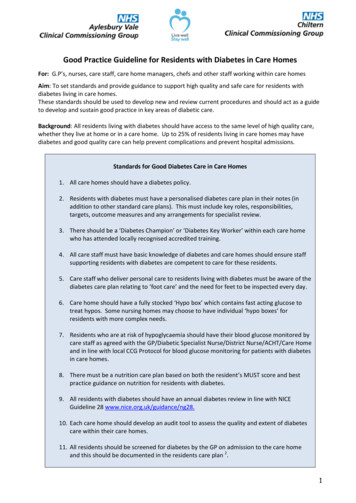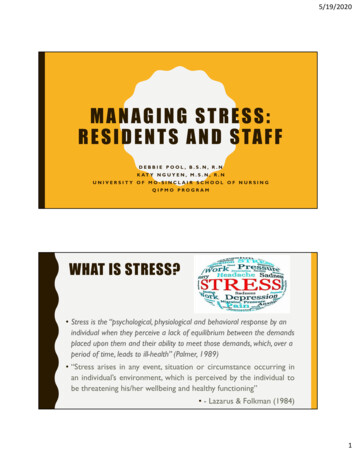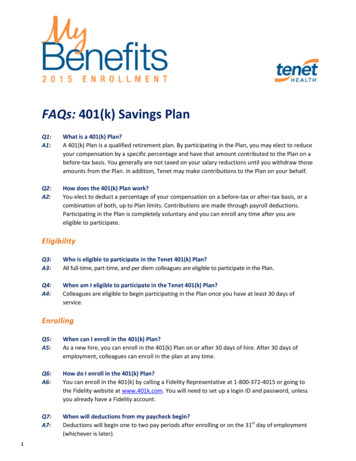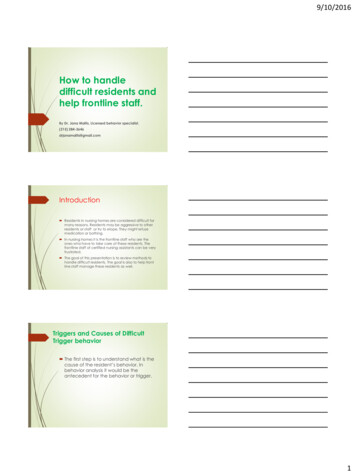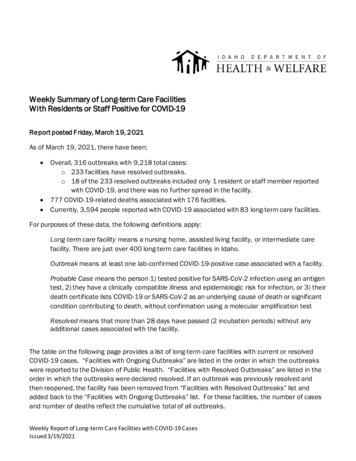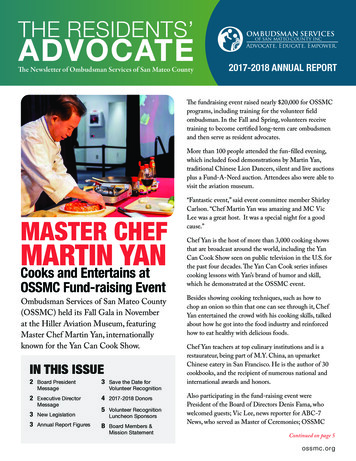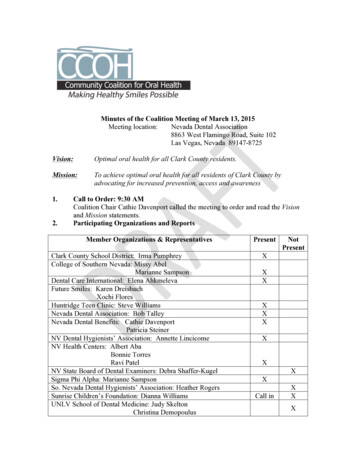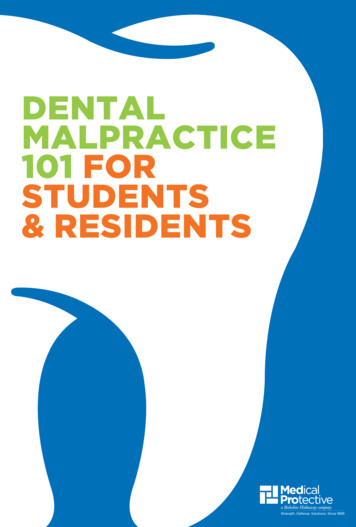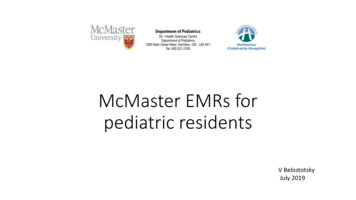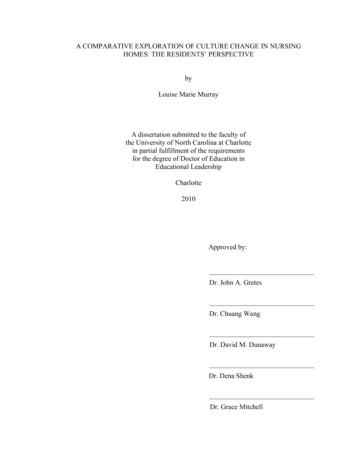
Transcription
iA COMPARATIVE EXPLORATION OF CULTURE CHANGE IN NURSINGHOMES: THE RESIDENTS’ PERSPECTIVEbyLouise Marie MurrayA dissertation submitted to the faculty ofthe University of North Carolina at Charlottein partial fulfillment of the requirementsfor the degree of Doctor of Education inEducational LeadershipCharlotte2010Approved by:Dr. John A. GretesDr. Chuang WangDr. David M. DunawayDr. Dena ShenkDr. Grace Mitchell
ii 2010Louise Marie MurrayALL RIGHTS RESERVED
iiiABSTRACTLOUISE MARIE MURRAY. A comparative exploration of culture change in nursinghomes: the residents’ perspective. (Under the direction of Dr. JOHN GRETES)The need to provide an environment that ensures both quality care and quality oflife for residents of nursing homes has long been recognized. The culture changemovement in nursing homes emphasizes both principles. This mixed-methodologyresearch explores the culture change process in nursing homes by evaluating to whatextent core principles of culture change: quality of life, resident choice and control, andresident satisfaction, are demonstrated in the behaviors, attitudes, and day-to-dayexperiences of the residents. Four groups of subjects in two not-for-profit nursing homes,in which culture change is being implemented, participated in this study. Data werecollected in the form of surveys and interviews from nursing home administrators,residents, direct care staff, and family members or friends of residents.The level of the culture change process was found to vary between the twonursing homes and a comparative inferential analysis of the quantitative data as to theresident quality of life, perceptions of choice and control, and level of satisfaction at thetwo nursing homes showed statistically significant differences in the quality of lifedomains of privacy and security only. No significant differences were found in residentsatisfaction with the nursing home or resident perceived latitude of control.The analysis of the qualitative data from the four groups of participants identifiedthe major themes in the categories of resident quality of life, perceptions of choice andcontrol, and level of satisfaction. Common themes in the factors reported as essential toquality of life by the residents at both nursing homes were quality of care, relationships,
ivactivities, physical/functional ability, faith, and safety/security. Relationships and faithwere again identified as common themes in the factors reported as essential tomaintaining control in their lives by the residents at both nursing homes as were attitudeand the ability to advocate for oneself. Only one theme common to both residents at bothnursing homes was identified as the worst thing about living in a nursing home and as thebest thing about living in a nursing home, the noise/behavior of other residents andrelationships respectively.Implications for practitioners include the recognition of the importance of bothpeer-relationships and relationships with staff to resident quality of life, choice andcontrol, and satisfaction and the process of adjustment to institutional living and theinfluence of resident attitude towards their living situation. Privacy and security werefound to be important factors in the experience of the residents as was quality of care.Recommendations for future research include longitudinal and qualitative studies toexplore resident perceptions of ongoing culture change and additional research to providean increased understanding of the mechanisms by which relationships are formed andmaintained between residents and staff in the long-term care environment. Furtherresearch exploring resident adjustment to institutional living, both in the short and longterm, would also be of value.
vDEDICATIONThis dissertation is dedicated in loving memory of my father, Frank Smeathers.
viACKNOWLEDGMENTSI would first like to thank my Chair, Dr. John Gretes. Thank you for yourknowledge and guidance, from which I have greatly benefited. I thank you for yourpositive attitude, for helping me to keep things in perspective, and moving me everforward. I really appreciate all your time and support and all you have done for me. Iwould also like to thank all my committee members. Dr. Chuang Wang, I have learned somuch from working with you. Thank you for going above and beyond in the hours youhave spent helping me in my work. Dr. Mickey Dunaway, thank you for starting thiswhole process off for me. You made me realize that I could combine all my researchinterests into one and embark on a dissertation that would be both enjoyable andchallenging. Dr. Dena Shenk, you introduced me to the field of gerontology and helpedme take my first steps into academia. I thank you for many years of encouragement,guidance, and friendship. Dr. Grace Mitchell, your enthusiasm and dedication to theEducational Leadership program at UNC Charlotte started me upon this path; I thank youfor your friendship and always valuable advice. Thank you for being with me at the endof this journey.Mike and Sindy, thank you for guiding me through the health care researchprocess. Mike, thank you for answering my endless questions and for telling me, “Youcan do it!” Much appreciated and much needed. Sindy, the world of geriatrics is a muchbetter place with you in it. Also, my thanks to my good friend Andrea; thank you forbeing a proof reader extraordinaire and thank you for listening!Last, but definitely not least, thank you to all my family, especially my muchneglected husband, Paul, and children, Christopher and Michael. Thank you Paul for your
viiconsistent and endless support and for helping me to achieve my dream! Thank you allfor putting up with me sitting, endlessly reading and typing, when I should have beenpaying you more attention. Chris, it’s your turn to be a UNC Charlotte student now! Also,big thanks to my mother, Ann Smeathers, and all my family, in-law’s, and friends in theUK for your long-distance encouragement and support.
viiiTABLE OF CONTENTSLIST OF TABLESLIST OF FIGURESCHAPTER 1: ns7Assumptions9Definitions9SummaryCHAPTER 2: LITERATURE REVIEWOrganizational Culture111313Socialization, Behavior, and the Diversity of Cultures14Levels of Organizational Culture and Assumptions15Organizational Culture Change16The Culture Change Process17Barriers to Successful Culture Change19The Nursing Home Organization22Past, Present, and Future of Nursing Homes22The Nursing Home Resident24Choice and Control among Nursing Home Residents26Quality of Life among Nursing Home Residents27Nursing Home Resident Satisfaction28
The Changing Culture of Nursing Homesix30Organizational Culture Change and Nursing Homes33Culture Change Models33The Eden Alternative34The Green House Project34The Neighborhood Model34Wellspring Nursing Home Alliance35The Pioneer Network35Efficacy of Culture Change in Nursing Homes36Statement of Purpose46Summary46CHAPTER 3: METHODOLOGY47Introduction47Research Design47Research Questions50Hypotheses51Procedures52Participants and SettingVariables5255Independent variableNursing home site, NH-A or NH-BDependent (Outcome) VariablesThe Level of the Culture Change Process55555555
Choice and Controlx55Quality of Life56Resident Satisfaction56Data CollectionNursing Home Administrators5656Quantitative Data Collection56Qualitative Data Collection57Nursing Home Residents58Quantitative Data Collection58Qualitative Data Collection59Family Members/Friends and Direct-Care StaffInstrumentation6062Nursing Home Administrator Data Collection Instrument62Nursing Home Administrator Interview Protocol63Nursing Home Resident Data Collection Instruments63Quality of Life63Latitude of Control65Resident Satisfaction66Nursing Home Residents Interview Protocol67Family Member/Friends and Direct-Care Staff Interview Protocol67Data Analysis67Quantitative67Qualitative68
Validityxi69Subjectivity Statement69Summary70CHAPTER 4: RESEARCH FINDINGSQuantitative Data7373Artifacts of Culture Change73Nursing Home Residents74Quality of Life75Resident Satisfaction77Perceived Latitude of Choice78Qualitative Data85Nursing Home Administrators86Culture Change86Quality of Life89Choice and Control91Resident Satisfaction93Nursing Home Residents94Quality of Life94Choice and Control99Resident SatisfactionDirect Care Staff101105Quality of Life106Choice and Control108
Resident SatisfactionFamily Members/Friends of Nursing Home Residentsxii109110Quality of Life111Choice and Control113Resident Satisfaction115SummaryCHAPTER 5: DISCUSSION, IMPLICATIONS FOR PRACTICE, ANDRECOMMENDATIONS FOR FUTURE RESEARCH117120Discussion120Implications for Practice130Recommendations for Future Research133Conclusion135REFERENCES136APPENDIX A: IRB APPROVAL LETTER HEALTH CARE ORGANIZATION146APPENDIX B: IRB APPROVAL LETTER UNC CHARLOTTE147APPENDIX C: IRB AUTHORIZATION AGREEMENT148APPENDIX D: NURSING HOME ADMINISTRATOR CONSENT TOPARTICIPATE IN SURVEY AND INTERVIEWS149APPENDIX E: NURSING HOME ADMINISTRATORS INTERVIEWPROTOCOL153APPENDIX F: POTENTIAL PARTICIPANTS FOR INCLUSIONIN THE STUDY154APPENDIX G: RESIDENT CONSENT TO PARTICIPATE IN SURVEY155APPENDIX H: RESIDENT CONSENT TO PARTICIPATE IN THEINTERVIEWS160APPENDIX I: RESIDENT INTERVIEW PROTOCOL165
xiiiAPPENDIX J: LETTER TO FAMILY MEMBERS INVITINGPARTICIPATION IN THE FOCUS GROUP/INTERVIEW166APPENDIX K: FAMILY MEMBERS/FRIENDS CONSENT TOPARTICIPATE IN THE FOCUS GROUP/INTERVIEW168APPENDIX L: LETTER TO DIRECT CARE STAFF INVITINGPARTICIPATION IN THE FOCUS GROUP/INTERVIEW172APPENDIX M: DIRECT CARE STAFF CONSENT TO PARTICIPATEIN THE FOCUS GROUP/INTERVIEW174APPENDIX N: FAMILY MEMBERS/FRIENDS INTERVIEW PROTOCOL178APPENDIX O: DIRECT-CARE STAFF INTERVIEW PROTOCOL179APPENDIX P: PERCIEVED LATITUDE OF CHOICE INSTRUMENT180APPENDIX Q: NURSING HOME ADMINISTRATORS QUALITATIVEDATA ANALYSIS182APPENDIX R: RESIDENTS QUALITATIVE DATA ANALYSISNURSING HOME A185APPENDIX S: RESIDENTS QUALITATIVE DATA ANALYSISNURSING HOME B188APPENDIX T: DIRECT CARE STAFF QUALITATIVE DATA ANALYSIS191APPENDIX U: FAMILY MEMBERS/FRIENDS QUALITATIVEDATA ANALYSIS193
xivLIST OF TABLESTABLE 1: Potential Barriers to the Culture Change Process20TABLE 2: Comparison of the Medical Model and Culture Change Models ofNursing Home Care32TABLE 3: The Culture Change Phenomenon in Nursing Homes38TABLE 4: Demographic Characteristics of Residents Completing the ResearcherAdministered Surveys54TABLE 5: Artifacts of Culture Change Scores74TABLE 6: Eleven Domain Quality of Life for Nursing Home Residents Scores76TABLE 7: Resident Satisfaction Mean Scores78TABLE 8: Perceived Latitude of Choice Item Mean Scores80TABLE 9: Perceived Latitude of Choice Mean Scores84
xvLIST OF FIGURESFIGURE 1: Resident Quality of Life: Frequencies, Categories, and Themes94FIGURE 2: Factors Important to Maintenance of Control: Frequencies, Categoriesand Themes100FIGURE 3: Worst Factors: Frequencies, Categories and Themes102FIGURE 4: Best Factors: Frequencies, Categories and Themes103
1CHAPTER 1: INTRODUCTIONOverviewAs life expectancy increases, and the population in the United States ages, it isbecoming increasingly vital that health care is provided in a manner in which the dignityand value of each and every human being is preserved. An essential component of longterm healthcare for older adults and adults of all ages is the skilled nursing facility, ornursing home. While the majority of nursing home residents are aged 65 years or older,this aspect of health care is not limited to this population. The 2004 National NursingHome Survey revealed that in that year 1,492,200 nursing home residents (1,317,3000aged 65 and older) received care in the vast network of facilities. These facilities vary intheir characteristics with 61.5% being proprietary and 38.5% voluntary non-profit(National Center for Health Care Statistics, n.d.). Risk factors of nursing home utilizationare identified as dementia, advancing age, functional disabilities, lack of social support,and the number of prescription medications utilized (Bharucha, Pandav, Shen, Dodge &Ganguli, 2004). Therefore, it is essential that quality care be provided in an appropriatemanner for these persons with physical, social, and psychological needs.The report, Crossing the Quality Chasm: A New Health System for the 21stCentury, by the Institute of Medicine (IOM) calls for a health care reform that providesfor the safety of the recipient by providing personalized care while focusing oneffectiveness, efficiency, and the timely delivery of equitable services. In order to achieve
2this, the IOM provides guidelines for redesign that include care individualized to patientpreference, values, and needs, and provision for patient control (Institute of Medicine,2001a). An additional IOM report addressing quality in long-term care (Institute ofMedicine, 2001b) highlights recent improvements in quality of care in nursing homes andquality of life among residents of nursing homes but also acknowledges inconsistenciesin the level of care provision and the need for continued improvement in the quality ofcare provided by such facilities. Thus, the prior model of care used by nursing homes, themedical model, is in need of reform in order to meet the changing needs of thepopulation.The medical model of care in nursing homes has been described as inadequateand failing to provide humanistic care, especially for persons in need of long-termservices (Reynolds, 2003). Indeed, this model of care has been charged with promoting asense of homelessness among the institutionalized (Carboni, 1990). Many believe that theextant organizational culture is not providing adequate results. Persons who seek care andshelter within this system become disempowered, dependent, and vulnerable (Carboni,1990). To address these problems, a movement advocating an organizational culturechange has arisen and is growing in momentum (Misiorski, 2003; Moles, 2006;Reynolds, 2003; Tellis-Nayak, 2007a).Organizational culture has been defined as “socially acquired and sharedknowledge that is embodied in specific and general organizational frames of reference”(Wilkins & Gibb Dyer, 1988, p.523). Schein (1993/2005) conceptualizes organizationalculture as encompassing three elements: socialization, deeply held assumptions, andrecognition that an organization can have more than one culture. Therefore, Schein
3defines organizational culture as a “pattern of shared basic assumptions that the grouplearned as it solved its problems of external adaptation and internal integration, that hasworked well enough to be considered valid and, therefore, to be taught to members as thecorrect way to perceive, think, and feel in relation to those problems” (pp. 364-365).In order for culture to change, the old culture must first be disrupted and a newculture established. Cultural change is a far more difficult task than cultural maintenanceand involves planned, deliberate, and substantial changes for organizations (Trice &Beyer, 1993/2005). The culture change movement in nursing homes focuses on both thephilosophy and the process of change (Mitty, 2005). It aims to create a culture basedupon the values of resident-centered or directed care, customer satisfaction,individualized care, empowerment of both residents and staff, enhancement of quality oflife, a sense of community, and choice and dignity (Grant & McMahon, 2008a;Misiorski, 2001; Mitty, 2005; Moles, 2006; Robinson & Rosher, 2006).Although there are various models of culture change, the core constructs thatunderlie them are identified by Grant and McMahon (2008c) as being: (1) residentdirected care and activities, (2) a home-like environment, (3) relationships, (4) staffempowerment, (5) collaborative management and shared leadership, and (6) ameasurement-based process of quality improvement.Many examples of this process of culture change are documented in the literatureand the benefits, barriers, and challenges to the implementation and sustenance of such achange are identifiable (Appel Doll, 2004; Grant & McMahon, 2008b; Keane &Shoesmith, 2005; Misiorski, 2001; Misiorski, 2003; Moles, 2006; Reynolds, 2003;Robinson & Rosher, 2006). Factors working against change range from regulatory
4constraints to terminology to sustainability of the change (Moles, 2006; Reynolds, 2003;Robinson & Rosher, 2006). Leadership, environmental factors, financial constraints, therequired initial investment, day-to-day operational issues, and staff and resident buy-in(Grant & McMahon, 2008b; Keane & Shoesmith, 2005; Misiorski, 2001) are allidentified as barriers to culture change in this context. Therefore, organizational culturechange in this context is a complex concept.The importance of evaluation in maintaining and improving this process has beenestablished (Misiorski, 2003; Mitty, 2005; Moles, 2006; Reynolds, 2003). However, thelack of empirical research supporting culture change in nursing homes is also clear.Indeed, the IOM Institute of Medicine (2001b) calls for empirical studies thatdemonstrate the value of models of culture change among nursing homes. Much of theresearch to date describes the process of implementing such a culture change and thechallenges to providing an in-depth evaluation of the process are evident. Prior researchhas provided little insight into the effects of the culture change process for the residentsthemselves. As the underlying philosophy of the culture change movement is to improvethe quality of the experience of the nursing home for residents, this appears to be a muchneglected facet of the evaluation.Culture change entails a considerable investment for the nursing home facilitiesthat commit to the process and involves significant and long-term changes within theorganization (Grant & McMahon, 2008b). Therefore, it is essential that further empiricalresearch is conducted to provide evidence to support such a process. While standardizedinstruments that will provide facilities with a method of assessing culture changeimplementation have been newly developed (Center for Medicare and Medicaid Services,
52006), the need for data pertaining to resident satisfaction and quality of life, and thechallenges of developing instrumentation to allow for these measures has beenhighlighted (Kane, 2003a; Rahman & Schnelle, 2008). Therefore, it is anticipated that thefindings of this research will serve to strengthen the culture change movement by addingan increased understanding of the resident perspective of both the process and theoutcomes. An in-depth exploration of this neglected perspective will give both voice tothe residents themselves and provide evidence regarding the value of this growingphilosophy of care.The overall goal of this research is to add to the growing body of literaturepertaining to culture change within nursing homes by providing an in-depth evaluation ofthe change process from the perspective of the long-term care resident. Therefore, thepurpose of this research is to explore the culture change process by evaluating to whatextent the core principles of culture change are demonstrated in the behaviors, attitudes,and day-to-day experiences of the residents in facilities in which culture change is beingimplemented.The research questions to be explored are:1. To what extent are different valued characteristics of culture change (quality of life,resident satisfaction, resident perceptions of choice and control) identified by longterm care residents?2. To what extent do valued characteristics of culture change identified by long-termresidents vary between facilities at different stages in the culture change process?3. What are the common elements of the experience of living in a nursing home for theresidents?
64. What are the similarities in the common elements of the experience of living in anursing home for the residents between two facilities at different stages in the culturechange process?5. What are the differences in the
A COMPARATIVE EXPLORATION OF CULTURE CHANGE IN NURSING HOMES: THE RESIDENTS’ PERSPECTIVE by Louise Marie Murray A dissertation submitted to the faculty of the University of North Carolina at Charlotte in partial fulfillment of the requirements for the degree of Doc
